Biology Report: Anemia - Causes, Diagnosis, and Treatment
VerifiedAdded on 2020/05/16
|6
|1339
|74
Report
AI Summary
This report provides a comprehensive overview of anemia, a condition characterized by a decrease in red blood cells. It categorizes anemia into normocytic, microcytic, and macrocytic types, discussing the characteristics of each. The report details specific conditions such as iron deficiency, thalassemia, vitamin B12 deficiency, and folic acid deficiency, including their diagnostic methods. It also explores normocytic anemia conditions like spherocytosis and elliptocytosis. The report further examines reticulocytes, their significance in anemia, and the causes of increased and decreased counts. It delves into the causes of iron deficiency, ranging from impaired absorption to inadequate intake and blood loss. The report highlights laboratory tests for diagnosis and discusses iron supplementation as a primary treatment, including dietary and medicinal approaches. Finally, it addresses anemia of chronic disease, its underlying mechanisms, and treatment strategies, including managing the underlying condition and using therapeutic agents like anti-TNF antibodies, blood transfusions, and erythropoietic agents.
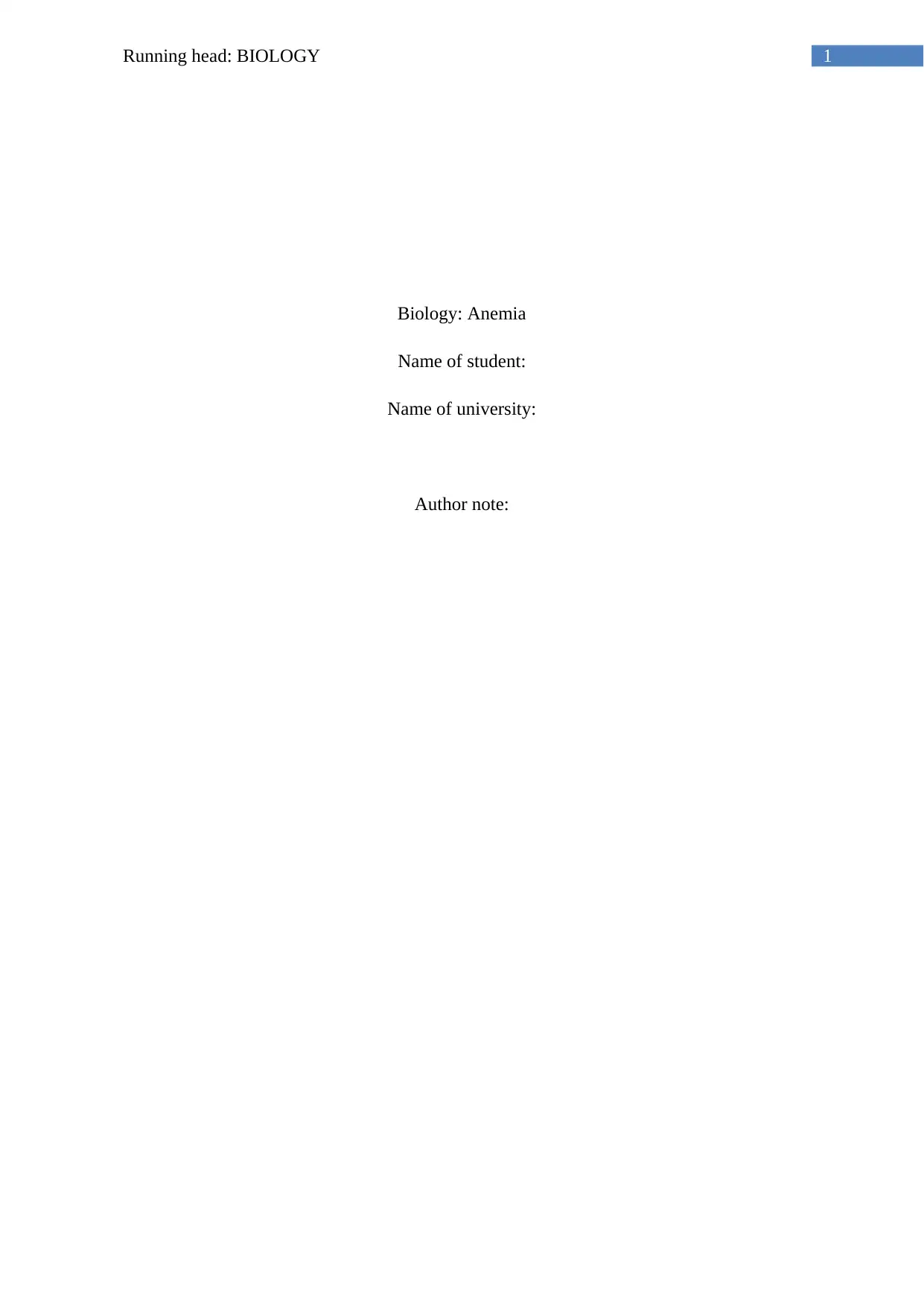
1Running head: BIOLOGY
Biology: Anemia
Name of student:
Name of university:
Author note:
Biology: Anemia
Name of student:
Name of university:
Author note:
Paraphrase This Document
Need a fresh take? Get an instant paraphrase of this document with our AI Paraphraser
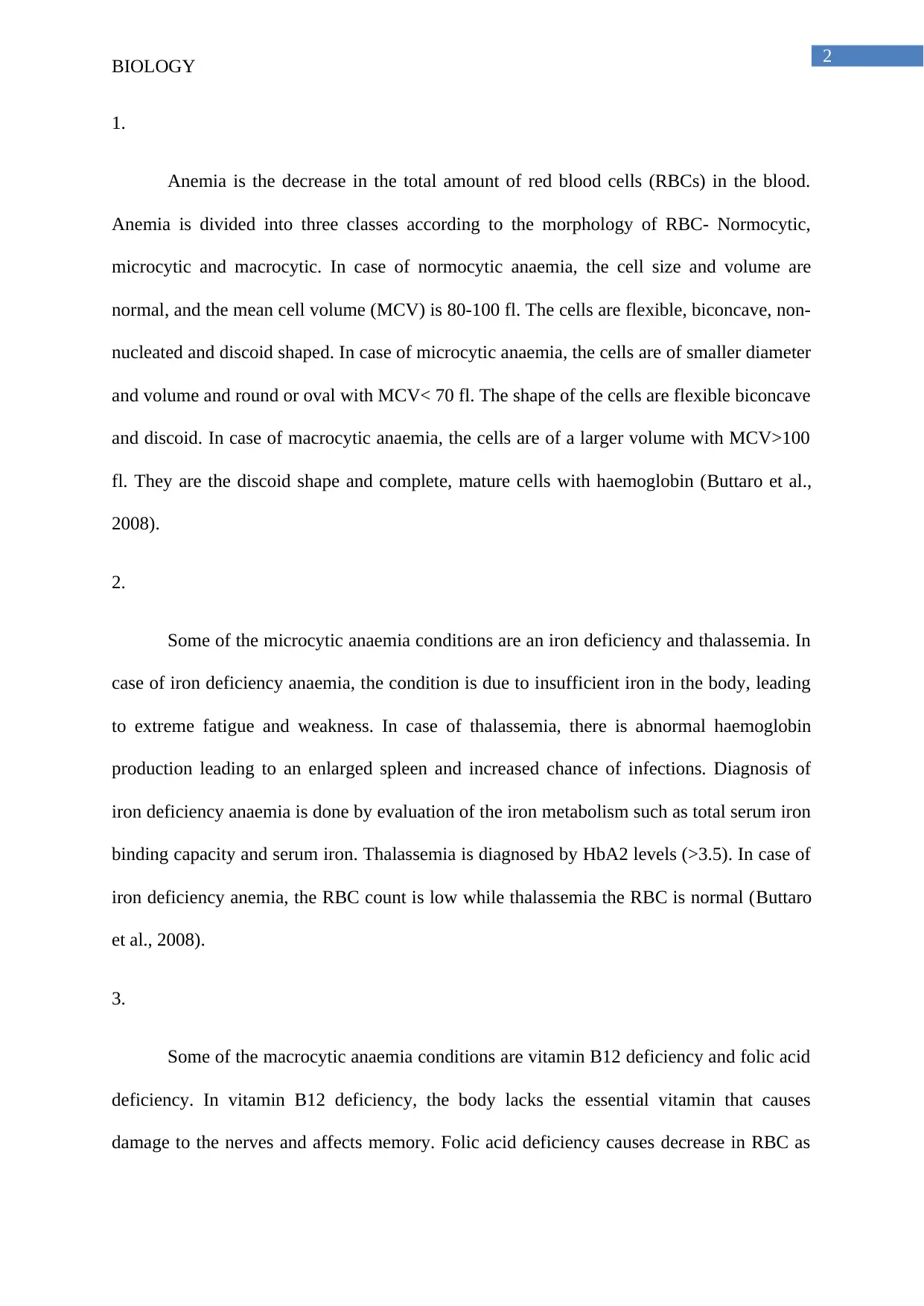
2
BIOLOGY
1.
Anemia is the decrease in the total amount of red blood cells (RBCs) in the blood.
Anemia is divided into three classes according to the morphology of RBC- Normocytic,
microcytic and macrocytic. In case of normocytic anaemia, the cell size and volume are
normal, and the mean cell volume (MCV) is 80-100 fl. The cells are flexible, biconcave, non-
nucleated and discoid shaped. In case of microcytic anaemia, the cells are of smaller diameter
and volume and round or oval with MCV< 70 fl. The shape of the cells are flexible biconcave
and discoid. In case of macrocytic anaemia, the cells are of a larger volume with MCV>100
fl. They are the discoid shape and complete, mature cells with haemoglobin (Buttaro et al.,
2008).
2.
Some of the microcytic anaemia conditions are an iron deficiency and thalassemia. In
case of iron deficiency anaemia, the condition is due to insufficient iron in the body, leading
to extreme fatigue and weakness. In case of thalassemia, there is abnormal haemoglobin
production leading to an enlarged spleen and increased chance of infections. Diagnosis of
iron deficiency anaemia is done by evaluation of the iron metabolism such as total serum iron
binding capacity and serum iron. Thalassemia is diagnosed by HbA2 levels (>3.5). In case of
iron deficiency anemia, the RBC count is low while thalassemia the RBC is normal (Buttaro
et al., 2008).
3.
Some of the macrocytic anaemia conditions are vitamin B12 deficiency and folic acid
deficiency. In vitamin B12 deficiency, the body lacks the essential vitamin that causes
damage to the nerves and affects memory. Folic acid deficiency causes decrease in RBC as
BIOLOGY
1.
Anemia is the decrease in the total amount of red blood cells (RBCs) in the blood.
Anemia is divided into three classes according to the morphology of RBC- Normocytic,
microcytic and macrocytic. In case of normocytic anaemia, the cell size and volume are
normal, and the mean cell volume (MCV) is 80-100 fl. The cells are flexible, biconcave, non-
nucleated and discoid shaped. In case of microcytic anaemia, the cells are of smaller diameter
and volume and round or oval with MCV< 70 fl. The shape of the cells are flexible biconcave
and discoid. In case of macrocytic anaemia, the cells are of a larger volume with MCV>100
fl. They are the discoid shape and complete, mature cells with haemoglobin (Buttaro et al.,
2008).
2.
Some of the microcytic anaemia conditions are an iron deficiency and thalassemia. In
case of iron deficiency anaemia, the condition is due to insufficient iron in the body, leading
to extreme fatigue and weakness. In case of thalassemia, there is abnormal haemoglobin
production leading to an enlarged spleen and increased chance of infections. Diagnosis of
iron deficiency anaemia is done by evaluation of the iron metabolism such as total serum iron
binding capacity and serum iron. Thalassemia is diagnosed by HbA2 levels (>3.5). In case of
iron deficiency anemia, the RBC count is low while thalassemia the RBC is normal (Buttaro
et al., 2008).
3.
Some of the macrocytic anaemia conditions are vitamin B12 deficiency and folic acid
deficiency. In vitamin B12 deficiency, the body lacks the essential vitamin that causes
damage to the nerves and affects memory. Folic acid deficiency causes decrease in RBC as
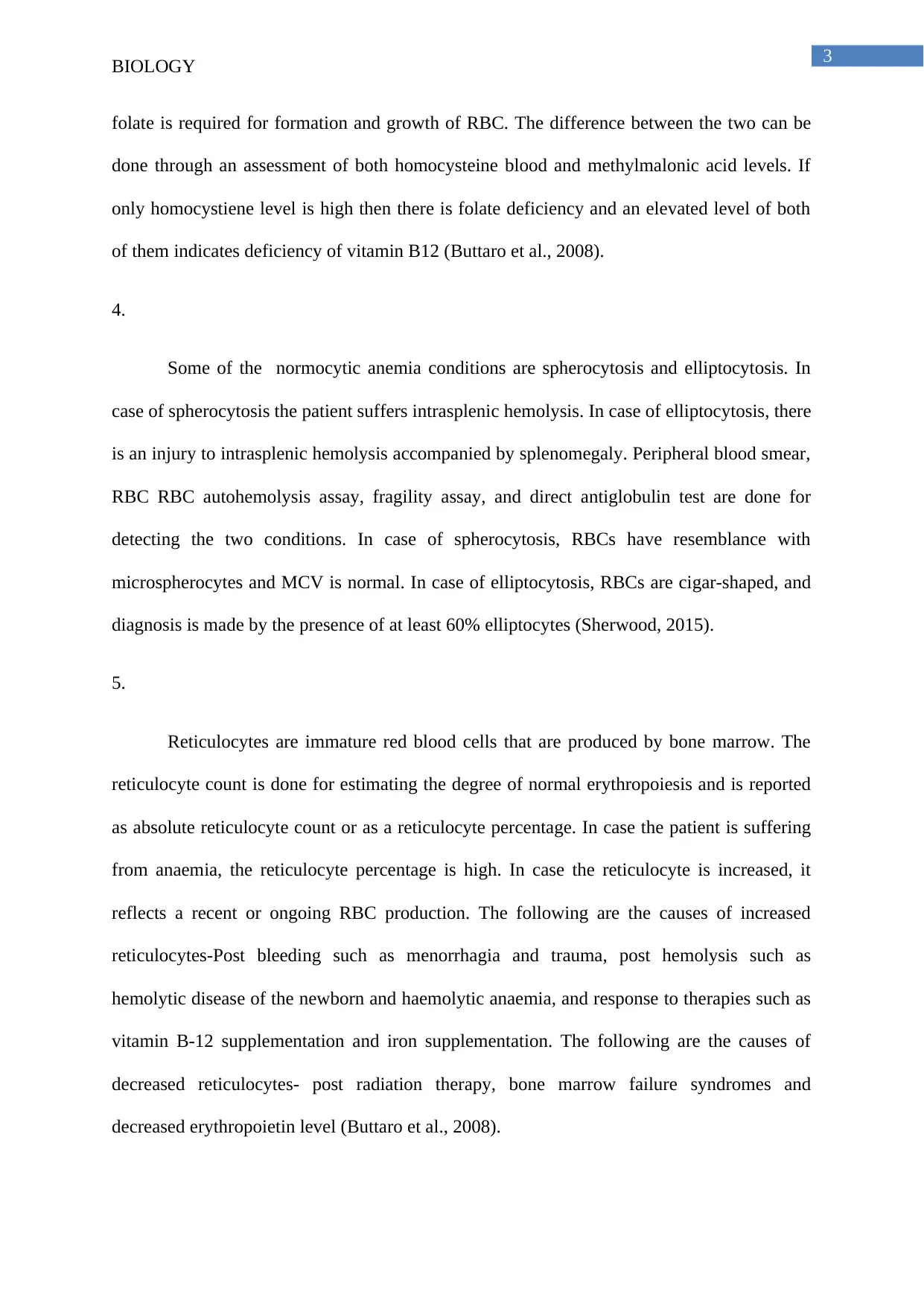
3
BIOLOGY
folate is required for formation and growth of RBC. The difference between the two can be
done through an assessment of both homocysteine blood and methylmalonic acid levels. If
only homocystiene level is high then there is folate deficiency and an elevated level of both
of them indicates deficiency of vitamin B12 (Buttaro et al., 2008).
4.
Some of the normocytic anemia conditions are spherocytosis and elliptocytosis. In
case of spherocytosis the patient suffers intrasplenic hemolysis. In case of elliptocytosis, there
is an injury to intrasplenic hemolysis accompanied by splenomegaly. Peripheral blood smear,
RBC RBC autohemolysis assay, fragility assay, and direct antiglobulin test are done for
detecting the two conditions. In case of spherocytosis, RBCs have resemblance with
microspherocytes and MCV is normal. In case of elliptocytosis, RBCs are cigar-shaped, and
diagnosis is made by the presence of at least 60% elliptocytes (Sherwood, 2015).
5.
Reticulocytes are immature red blood cells that are produced by bone marrow. The
reticulocyte count is done for estimating the degree of normal erythropoiesis and is reported
as absolute reticulocyte count or as a reticulocyte percentage. In case the patient is suffering
from anaemia, the reticulocyte percentage is high. In case the reticulocyte is increased, it
reflects a recent or ongoing RBC production. The following are the causes of increased
reticulocytes-Post bleeding such as menorrhagia and trauma, post hemolysis such as
hemolytic disease of the newborn and haemolytic anaemia, and response to therapies such as
vitamin B-12 supplementation and iron supplementation. The following are the causes of
decreased reticulocytes- post radiation therapy, bone marrow failure syndromes and
decreased erythropoietin level (Buttaro et al., 2008).
BIOLOGY
folate is required for formation and growth of RBC. The difference between the two can be
done through an assessment of both homocysteine blood and methylmalonic acid levels. If
only homocystiene level is high then there is folate deficiency and an elevated level of both
of them indicates deficiency of vitamin B12 (Buttaro et al., 2008).
4.
Some of the normocytic anemia conditions are spherocytosis and elliptocytosis. In
case of spherocytosis the patient suffers intrasplenic hemolysis. In case of elliptocytosis, there
is an injury to intrasplenic hemolysis accompanied by splenomegaly. Peripheral blood smear,
RBC RBC autohemolysis assay, fragility assay, and direct antiglobulin test are done for
detecting the two conditions. In case of spherocytosis, RBCs have resemblance with
microspherocytes and MCV is normal. In case of elliptocytosis, RBCs are cigar-shaped, and
diagnosis is made by the presence of at least 60% elliptocytes (Sherwood, 2015).
5.
Reticulocytes are immature red blood cells that are produced by bone marrow. The
reticulocyte count is done for estimating the degree of normal erythropoiesis and is reported
as absolute reticulocyte count or as a reticulocyte percentage. In case the patient is suffering
from anaemia, the reticulocyte percentage is high. In case the reticulocyte is increased, it
reflects a recent or ongoing RBC production. The following are the causes of increased
reticulocytes-Post bleeding such as menorrhagia and trauma, post hemolysis such as
hemolytic disease of the newborn and haemolytic anaemia, and response to therapies such as
vitamin B-12 supplementation and iron supplementation. The following are the causes of
decreased reticulocytes- post radiation therapy, bone marrow failure syndromes and
decreased erythropoietin level (Buttaro et al., 2008).
⊘ This is a preview!⊘
Do you want full access?
Subscribe today to unlock all pages.

Trusted by 1+ million students worldwide
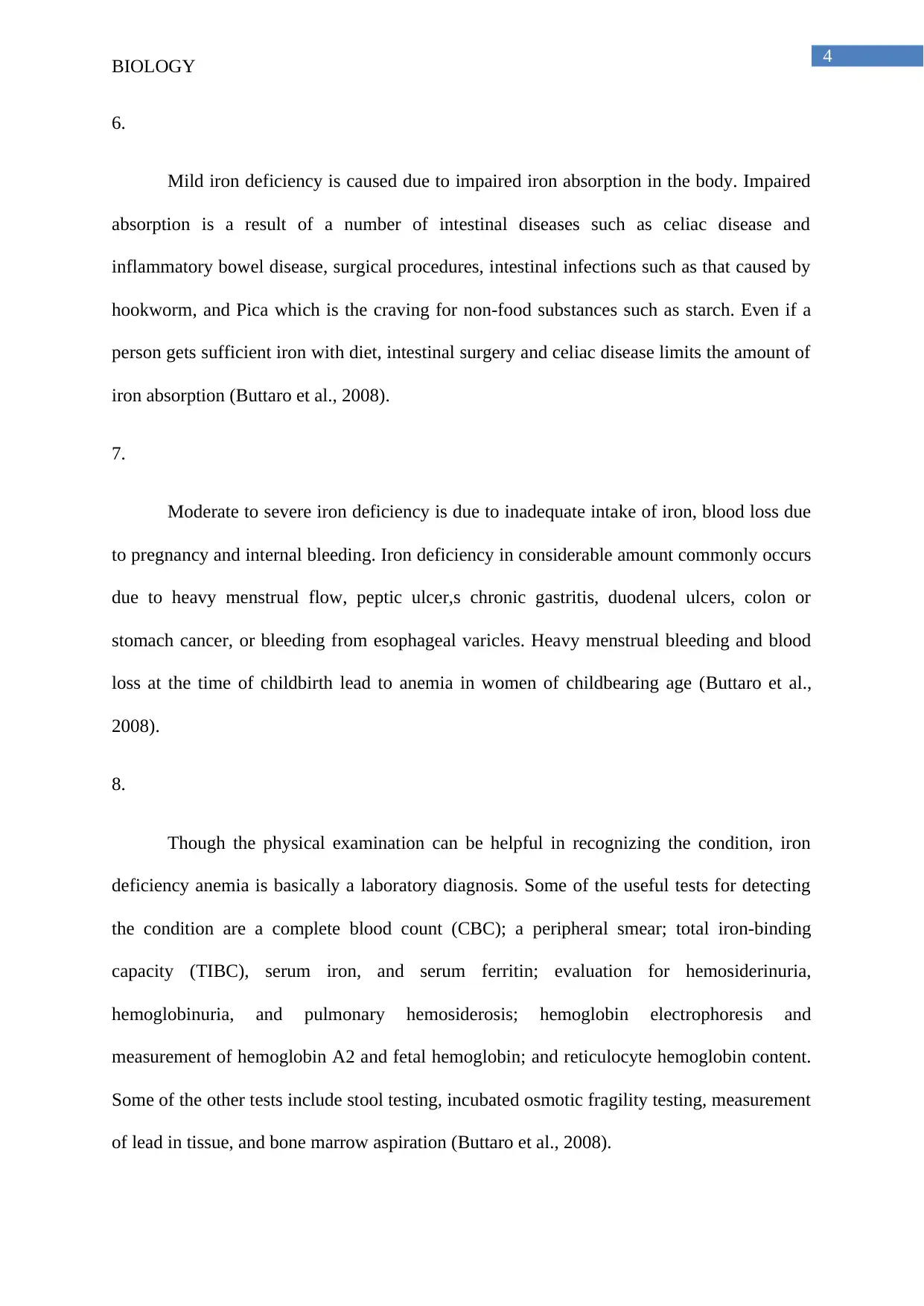
4
BIOLOGY
6.
Mild iron deficiency is caused due to impaired iron absorption in the body. Impaired
absorption is a result of a number of intestinal diseases such as celiac disease and
inflammatory bowel disease, surgical procedures, intestinal infections such as that caused by
hookworm, and Pica which is the craving for non-food substances such as starch. Even if a
person gets sufficient iron with diet, intestinal surgery and celiac disease limits the amount of
iron absorption (Buttaro et al., 2008).
7.
Moderate to severe iron deficiency is due to inadequate intake of iron, blood loss due
to pregnancy and internal bleeding. Iron deficiency in considerable amount commonly occurs
due to heavy menstrual flow, peptic ulcer,s chronic gastritis, duodenal ulcers, colon or
stomach cancer, or bleeding from esophageal varicles. Heavy menstrual bleeding and blood
loss at the time of childbirth lead to anemia in women of childbearing age (Buttaro et al.,
2008).
8.
Though the physical examination can be helpful in recognizing the condition, iron
deficiency anemia is basically a laboratory diagnosis. Some of the useful tests for detecting
the condition are a complete blood count (CBC); a peripheral smear; total iron-binding
capacity (TIBC), serum iron, and serum ferritin; evaluation for hemosiderinuria,
hemoglobinuria, and pulmonary hemosiderosis; hemoglobin electrophoresis and
measurement of hemoglobin A2 and fetal hemoglobin; and reticulocyte hemoglobin content.
Some of the other tests include stool testing, incubated osmotic fragility testing, measurement
of lead in tissue, and bone marrow aspiration (Buttaro et al., 2008).
BIOLOGY
6.
Mild iron deficiency is caused due to impaired iron absorption in the body. Impaired
absorption is a result of a number of intestinal diseases such as celiac disease and
inflammatory bowel disease, surgical procedures, intestinal infections such as that caused by
hookworm, and Pica which is the craving for non-food substances such as starch. Even if a
person gets sufficient iron with diet, intestinal surgery and celiac disease limits the amount of
iron absorption (Buttaro et al., 2008).
7.
Moderate to severe iron deficiency is due to inadequate intake of iron, blood loss due
to pregnancy and internal bleeding. Iron deficiency in considerable amount commonly occurs
due to heavy menstrual flow, peptic ulcer,s chronic gastritis, duodenal ulcers, colon or
stomach cancer, or bleeding from esophageal varicles. Heavy menstrual bleeding and blood
loss at the time of childbirth lead to anemia in women of childbearing age (Buttaro et al.,
2008).
8.
Though the physical examination can be helpful in recognizing the condition, iron
deficiency anemia is basically a laboratory diagnosis. Some of the useful tests for detecting
the condition are a complete blood count (CBC); a peripheral smear; total iron-binding
capacity (TIBC), serum iron, and serum ferritin; evaluation for hemosiderinuria,
hemoglobinuria, and pulmonary hemosiderosis; hemoglobin electrophoresis and
measurement of hemoglobin A2 and fetal hemoglobin; and reticulocyte hemoglobin content.
Some of the other tests include stool testing, incubated osmotic fragility testing, measurement
of lead in tissue, and bone marrow aspiration (Buttaro et al., 2008).
Paraphrase This Document
Need a fresh take? Get an instant paraphrase of this document with our AI Paraphraser
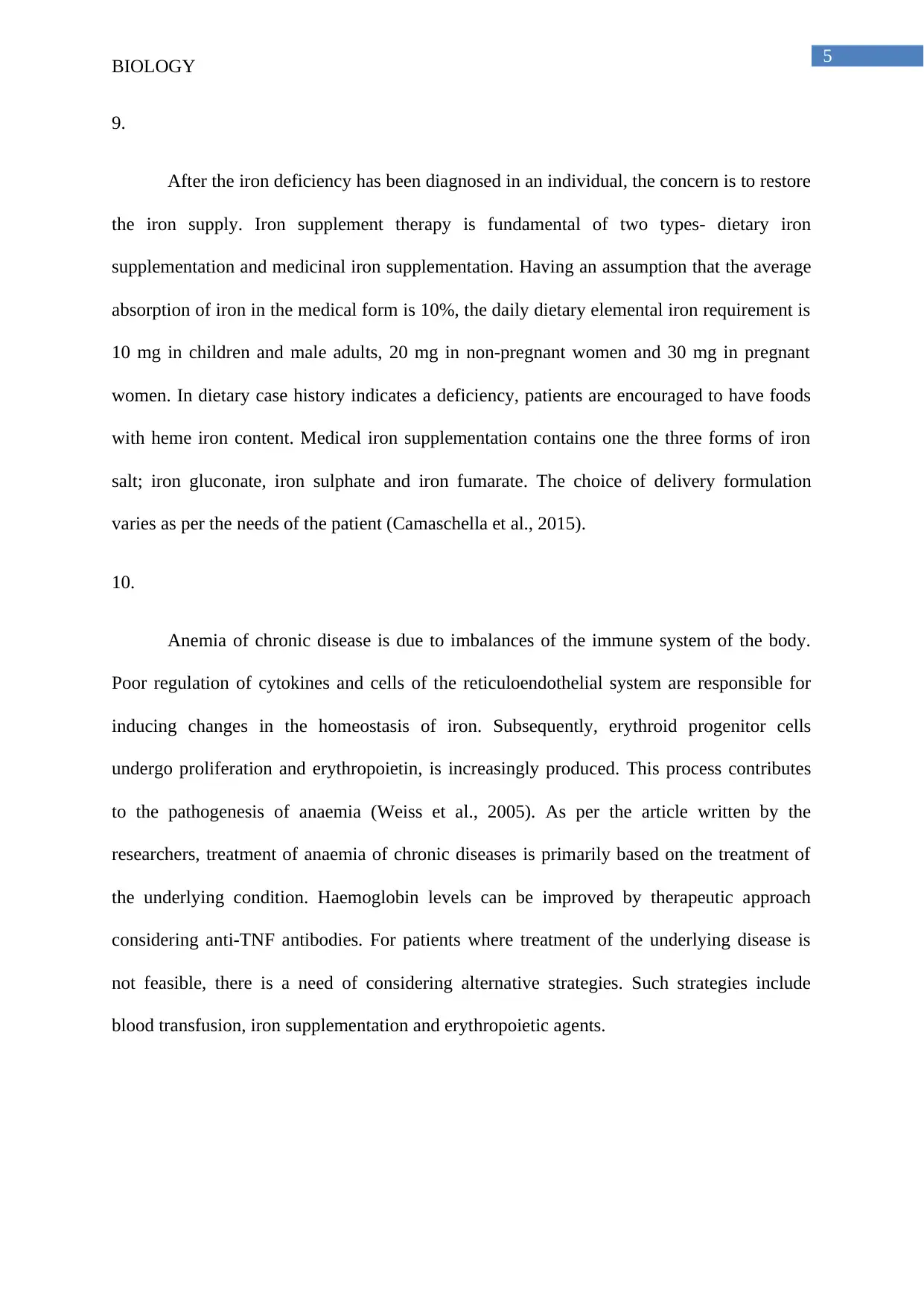
5
BIOLOGY
9.
After the iron deficiency has been diagnosed in an individual, the concern is to restore
the iron supply. Iron supplement therapy is fundamental of two types- dietary iron
supplementation and medicinal iron supplementation. Having an assumption that the average
absorption of iron in the medical form is 10%, the daily dietary elemental iron requirement is
10 mg in children and male adults, 20 mg in non-pregnant women and 30 mg in pregnant
women. In dietary case history indicates a deficiency, patients are encouraged to have foods
with heme iron content. Medical iron supplementation contains one the three forms of iron
salt; iron gluconate, iron sulphate and iron fumarate. The choice of delivery formulation
varies as per the needs of the patient (Camaschella et al., 2015).
10.
Anemia of chronic disease is due to imbalances of the immune system of the body.
Poor regulation of cytokines and cells of the reticuloendothelial system are responsible for
inducing changes in the homeostasis of iron. Subsequently, erythroid progenitor cells
undergo proliferation and erythropoietin, is increasingly produced. This process contributes
to the pathogenesis of anaemia (Weiss et al., 2005). As per the article written by the
researchers, treatment of anaemia of chronic diseases is primarily based on the treatment of
the underlying condition. Haemoglobin levels can be improved by therapeutic approach
considering anti-TNF antibodies. For patients where treatment of the underlying disease is
not feasible, there is a need of considering alternative strategies. Such strategies include
blood transfusion, iron supplementation and erythropoietic agents.
BIOLOGY
9.
After the iron deficiency has been diagnosed in an individual, the concern is to restore
the iron supply. Iron supplement therapy is fundamental of two types- dietary iron
supplementation and medicinal iron supplementation. Having an assumption that the average
absorption of iron in the medical form is 10%, the daily dietary elemental iron requirement is
10 mg in children and male adults, 20 mg in non-pregnant women and 30 mg in pregnant
women. In dietary case history indicates a deficiency, patients are encouraged to have foods
with heme iron content. Medical iron supplementation contains one the three forms of iron
salt; iron gluconate, iron sulphate and iron fumarate. The choice of delivery formulation
varies as per the needs of the patient (Camaschella et al., 2015).
10.
Anemia of chronic disease is due to imbalances of the immune system of the body.
Poor regulation of cytokines and cells of the reticuloendothelial system are responsible for
inducing changes in the homeostasis of iron. Subsequently, erythroid progenitor cells
undergo proliferation and erythropoietin, is increasingly produced. This process contributes
to the pathogenesis of anaemia (Weiss et al., 2005). As per the article written by the
researchers, treatment of anaemia of chronic diseases is primarily based on the treatment of
the underlying condition. Haemoglobin levels can be improved by therapeutic approach
considering anti-TNF antibodies. For patients where treatment of the underlying disease is
not feasible, there is a need of considering alternative strategies. Such strategies include
blood transfusion, iron supplementation and erythropoietic agents.
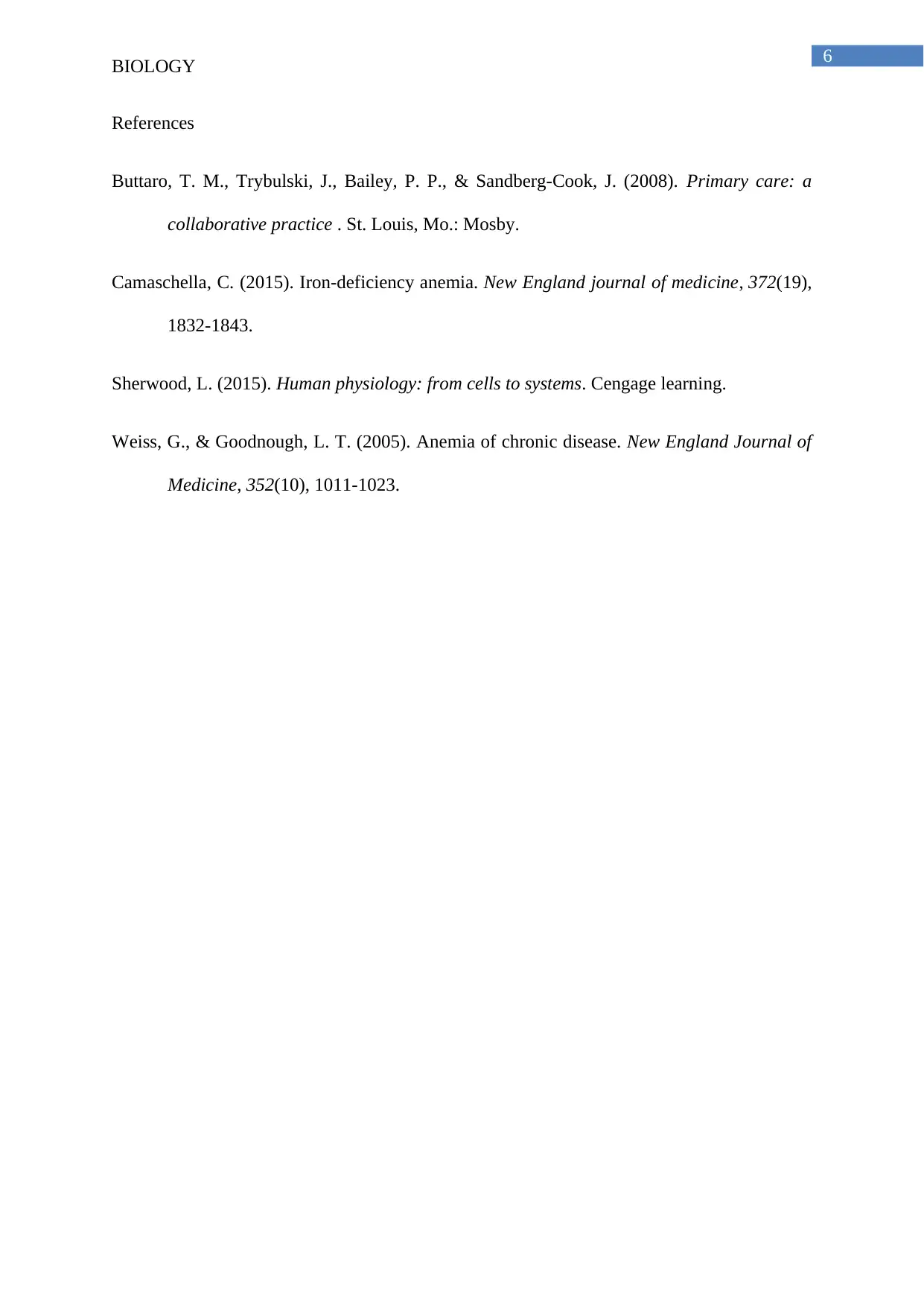
6
BIOLOGY
References
Buttaro, T. M., Trybulski, J., Bailey, P. P., & Sandberg-Cook, J. (2008). Primary care: a
collaborative practice . St. Louis, Mo.: Mosby.
Camaschella, C. (2015). Iron-deficiency anemia. New England journal of medicine, 372(19),
1832-1843.
Sherwood, L. (2015). Human physiology: from cells to systems. Cengage learning.
Weiss, G., & Goodnough, L. T. (2005). Anemia of chronic disease. New England Journal of
Medicine, 352(10), 1011-1023.
BIOLOGY
References
Buttaro, T. M., Trybulski, J., Bailey, P. P., & Sandberg-Cook, J. (2008). Primary care: a
collaborative practice . St. Louis, Mo.: Mosby.
Camaschella, C. (2015). Iron-deficiency anemia. New England journal of medicine, 372(19),
1832-1843.
Sherwood, L. (2015). Human physiology: from cells to systems. Cengage learning.
Weiss, G., & Goodnough, L. T. (2005). Anemia of chronic disease. New England Journal of
Medicine, 352(10), 1011-1023.
⊘ This is a preview!⊘
Do you want full access?
Subscribe today to unlock all pages.

Trusted by 1+ million students worldwide
1 out of 6
Related Documents
Your All-in-One AI-Powered Toolkit for Academic Success.
+13062052269
info@desklib.com
Available 24*7 on WhatsApp / Email
![[object Object]](/_next/static/media/star-bottom.7253800d.svg)
Unlock your academic potential
Copyright © 2020–2025 A2Z Services. All Rights Reserved. Developed and managed by ZUCOL.





